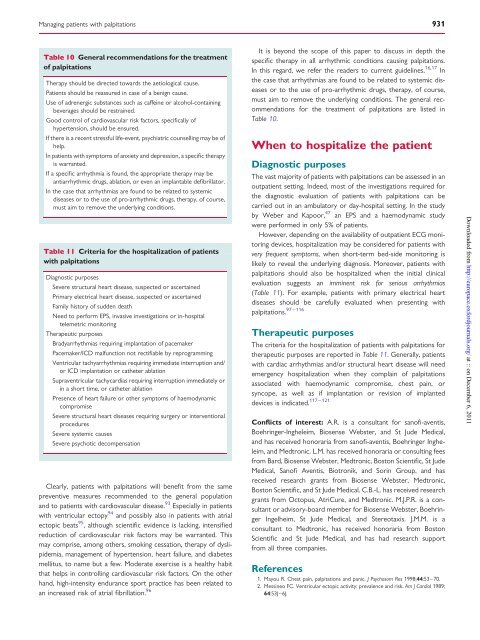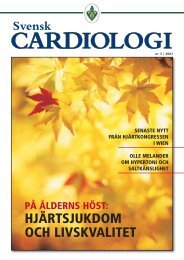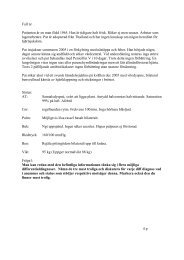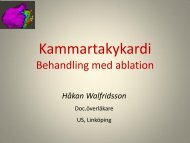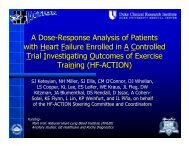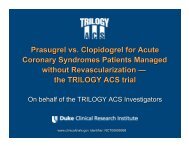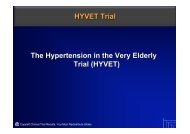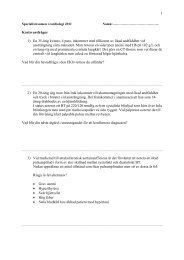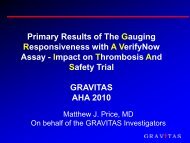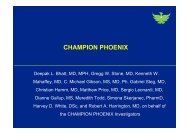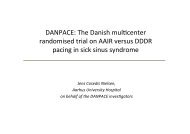Managing <strong>patients</strong> <strong>with</strong> <strong>palpitations</strong> 931Table 10 General recommendations for <strong>the</strong> treatment<strong>of</strong> <strong>palpitations</strong>Therapy should be directed towards <strong>the</strong> aetiological cause.Patients should be reassured in case <strong>of</strong> a benign cause.Use <strong>of</strong> adrenergic substances such as caffeine or alcohol-containingbeverages should be restrained.Good control <strong>of</strong> cardiovascular risk factors, specifically <strong>of</strong>hypertension, should be ensured.If <strong>the</strong>re is a recent stressful life-event, psychiatric counselling may be <strong>of</strong>help.In <strong>patients</strong> <strong>with</strong> symptoms <strong>of</strong> anxiety and depression, a specific <strong>the</strong>rapyis warranted.If a specific arrhythmia is found, <strong>the</strong> appropriate <strong>the</strong>rapy may beantiarrhythmic drugs, ablation, or even an implantable defibrillator.In <strong>the</strong> case that arrhythmias are found to be related to systemicdiseases or to <strong>the</strong> use <strong>of</strong> pro-arrhythmic drugs, <strong>the</strong>rapy, <strong>of</strong> course,must aim to remove <strong>the</strong> underlying conditions.Table 11 Criteria for <strong>the</strong> hospitalization <strong>of</strong> <strong>patients</strong><strong>with</strong> <strong>palpitations</strong>Diagnostic purposesSevere structural heart disease, suspected or ascertainedPrimary electrical heart disease, suspected or ascertainedFamily history <strong>of</strong> sudden deathNeed to perform EPS, invasive investigations or in-hospitaltelemetric monitoringTherapeutic purposesBradyarrhythmias requiring implantation <strong>of</strong> pacemakerPacemaker/ICD malfunction not rectifiable by reprogrammingVentricular tachyarrhythmias requiring immediate interruption and/or ICD implantation or ca<strong>the</strong>ter ablationSupraventricular tachycardias requiring interruption immediately orin a short time, or ca<strong>the</strong>ter ablationPresence <strong>of</strong> heart failure or o<strong>the</strong>r symptoms <strong>of</strong> haemodynamiccompromiseSevere structural heart diseases requiring surgery or interventionalproceduresSevere systemic causesSevere psychotic decompensationClearly, <strong>patients</strong> <strong>with</strong> <strong>palpitations</strong> will benefit <strong>from</strong> <strong>the</strong> samepreventive measures recommended to <strong>the</strong> general populationand to <strong>patients</strong> <strong>with</strong> cardiovascular disease. 93 Especially in <strong>patients</strong><strong>with</strong> ventricular ectopy 94 and possibly also in <strong>patients</strong> <strong>with</strong> atrialectopic beats 95 , although scientific evidence is lacking, intensifiedreduction <strong>of</strong> cardiovascular risk factors may be warranted. Thismay comprise, among o<strong>the</strong>rs, smoking cessation, <strong>the</strong>rapy <strong>of</strong> dyslipidemia,management <strong>of</strong> hypertension, heart failure, and diabetesmellitus, to name but a few. Moderate exercise is a healthy habitthat helps in controlling cardiovascular risk factors. On <strong>the</strong> o<strong>the</strong>rhand, high-intensity endurance sport practice has been related toan increased risk <strong>of</strong> atrial fibrillation. 96It is beyond <strong>the</strong> scope <strong>of</strong> this <strong>paper</strong> to discuss in depth <strong>the</strong>specific <strong>the</strong>rapy in all arrhythmic conditions causing <strong>palpitations</strong>.In this regard, we refer <strong>the</strong> readers to current guidelines. 16,17 In<strong>the</strong> case that arrhythmias are found to be related to systemic diseasesor to <strong>the</strong> use <strong>of</strong> pro-arrhythmic drugs, <strong>the</strong>rapy, <strong>of</strong> course,must aim to remove <strong>the</strong> underlying conditions. The general recommendationsfor <strong>the</strong> treatment <strong>of</strong> <strong>palpitations</strong> are listed inTable 10.When to hospitalize <strong>the</strong> patientDiagnostic purposesThe vast majority <strong>of</strong> <strong>patients</strong> <strong>with</strong> <strong>palpitations</strong> can be assessed in anoutpatient setting. Indeed, most <strong>of</strong> <strong>the</strong> investigations required for<strong>the</strong> diagnostic evaluation <strong>of</strong> <strong>patients</strong> <strong>with</strong> <strong>palpitations</strong> can becarried out in an ambulatory or day-hospital setting. In <strong>the</strong> studyby Weber and Kapoor, 47 an EPS and a haemodynamic studywere performed in only 5% <strong>of</strong> <strong>patients</strong>.However, depending on <strong>the</strong> availability <strong>of</strong> outpatient ECG monitoringdevices, hospitalization may be considered for <strong>patients</strong> <strong>with</strong>very frequent symptoms, when short-term bed-side monitoring islikely to reveal <strong>the</strong> underlying diagnosis. Moreover, <strong>patients</strong> <strong>with</strong><strong>palpitations</strong> should also be hospitalized when <strong>the</strong> initial clinicalevaluation suggests an imminent risk for serious arrhythmias(Table 11). For example, <strong>patients</strong> <strong>with</strong> primary electrical heartdiseases should be carefully evaluated when presenting <strong>with</strong>97 – 116<strong>palpitations</strong>.Therapeutic purposesThe criteria for <strong>the</strong> hospitalization <strong>of</strong> <strong>patients</strong> <strong>with</strong> <strong>palpitations</strong> for<strong>the</strong>rapeutic purposes are reported in Table 11. Generally, <strong>patients</strong><strong>with</strong> cardiac arrhythmias and/or structural heart disease will needemergency hospitalization when <strong>the</strong>y complain <strong>of</strong> <strong>palpitations</strong>associated <strong>with</strong> haemodynamic compromise, chest pain, orsyncope, as well as if implantation or revision <strong>of</strong> implanted117 – 121devices is indicated.Conflicts <strong>of</strong> interest: A.R. is a consultant for san<strong>of</strong>i-aventis,Boehringer-Ingheleim, Biosense Webster, and St Jude Medical,and has received honoraria <strong>from</strong> san<strong>of</strong>i-aventis, Boehringer Ingheleim,and Medtronic. L.M. has received honoraria or consulting fees<strong>from</strong> Bard, Biosense Webster, Medtronic, Boston Scientific, St JudeMedical, San<strong>of</strong>i Aventis, Biotronik, and Sorin Group, and hasreceived research grants <strong>from</strong> Biosense Webster, Medtronic,Boston Scientific, and St Jude Medical. C.B.-L. has received researchgrants <strong>from</strong> Octopus, AtriCure, and Medtronic. M.J.P.R. is a consultantor advisory-board member for Biosense Webster, BoehringerIngelheim, St Jude Medical, and Stereotaxis. J.M.M. is aconsultant to Medtronic, has received honoraria <strong>from</strong> BostonScientific and St Jude Medical, and has had research support<strong>from</strong> all three companies.References1. Mayou R. Chest pain, <strong>palpitations</strong> and panic. J Psychosom Res 1998;44:53–70.2. Messineo FC. Ventricular ectopic activity: prevalence and risk. Am J Cardiol 1989;64:53J–6J.Downloaded <strong>from</strong> http://europace.oxfordjournals.org/ at :: on December 6, 2011
932A. Raviele et al.3. Kroenke K, Arrington ME, Mangelsdr<strong>of</strong>f AD. The prevalence <strong>of</strong> symptoms inmedical out<strong>patients</strong> and <strong>the</strong> adequacy <strong>of</strong> <strong>the</strong>rapy. Arch Intern Med 1990;150:1685–9.4. Knudson MP. The natural history <strong>of</strong> <strong>palpitations</strong> in a family practice. J Fam Pract1987;24:357–60.5. Zimetbaum P, Josephson ME. Evaluation <strong>of</strong> <strong>patients</strong> <strong>with</strong> <strong>palpitations</strong>. New Engl JMed 1998;338:1369–73.6. Giada F, Raviele A. Diagnostic management <strong>of</strong> <strong>patients</strong> <strong>with</strong> <strong>palpitations</strong> <strong>of</strong>unknown origin. Ital Heart J 2004;5:581–6.7. Brugada P, Gursoy S, Brugada J, Andries E. Investigation <strong>of</strong> <strong>palpitations</strong>. Lancet1993;341:1254–8.8. Pickett CC, Zimetbaum PJ. Palpitations: a proper evaluation and approach toeffective medical <strong>the</strong>rapy. Curr Cardiol Rep 2005;7:362–7.9. Abbott AV. Diagnostic approach to <strong>palpitations</strong>. Am Fam Physician 2005;71:743–50.10. Malliani A, Lombardi F, Pagani M. Sensory innervation <strong>of</strong> <strong>the</strong> heart. In: Cervero F,Morrison JFB (eds). Progress in Brain Research. vol. 617. New York: Elsevier; 1986.p39–48.11. Sugishita K, Shiono E, Sugiyama T, Ashida T. Diabetes influences <strong>the</strong> cardiacsymptoms related to atrial fibrillation. Circ J 2003;67:835–8.12. Barsky AJ, Ahern DK, Brener J, Surman OS, Ring C, Dec W. Palpitations andcardiac awareness after heart transplantation. Psychosomatic Med 1998;60:557–62.13. Kirchh<strong>of</strong> P, Auricchio A, Bax J, Crijns H, Camm J, Diener HC et al. Outcomeparameters for trials in atrial fibrillation. Europace 2007;9:1006–23.14. Camm J, Kirchh<strong>of</strong> P, Lip GYH, Schotten U, Saveliera I, Ernst S et al. Guidelinesfor <strong>the</strong> management <strong>of</strong> atrial fibrillation. The task force for <strong>the</strong> management<strong>of</strong> atrial fibrillation <strong>of</strong> <strong>the</strong> European Society <strong>of</strong> Cardiology. Eur Heart J 2010;31:2369–429.15. Flaker JC, Belew KRN, Beckman K, Vidaillet H, Kron J, Safford R et al. Asymptomaticatrial fibrillation: demographic features and prognostic information <strong>from</strong><strong>the</strong> Atrial Fibrillation Follow-up Investigation <strong>of</strong> Rhythm <strong>Management</strong>(AFFIRM) study. Am Heart J 2005;149:657–63.16. Blomström-Lundqvist C, Scheinman MM, Aliot EM, Alpert JS, Calkins H,Camm JA et al. ACC/AHA/ESC Guidelines for <strong>the</strong> management <strong>of</strong> <strong>patients</strong><strong>with</strong> supraventricular arrhythmias—executive summary: a report <strong>of</strong> <strong>the</strong> AmericanCollege <strong>of</strong> Cardiology/American Heart Association Task Force on PracticeGuidelines and <strong>the</strong> European Society <strong>of</strong> Cardiology Committee for PracticeGuidelines (Writing Committee to Develop Guidelines for <strong>the</strong> <strong>Management</strong><strong>of</strong> Patients With Supraventricular Arrhythmias). Circulation 2003;108:1871–909.17. Zipes DP, Camm AJ, Borggrefe M, Buxton AE, Chaitman B, Fromer M et al.ACC/AHA/ESC 2006 Guidelines for management <strong>of</strong> <strong>patients</strong> <strong>with</strong> ventriculararrhythmias and <strong>the</strong> prevention <strong>of</strong> sudden cardiac death: a report <strong>of</strong> <strong>the</strong> AmericanCollege <strong>of</strong> Cardiology/American Heart Association Task Force and <strong>the</strong>European Society <strong>of</strong> Cardiology Committee for Practice Guidelines (WritingCommittee to Develop Guidelines for <strong>Management</strong> <strong>of</strong> Patients With VentricularArrhythmias and <strong>the</strong> Prevention <strong>of</strong> Sudden Cardiac Death): developed in collaboration<strong>with</strong> <strong>the</strong> European Heart Rhythm Association and <strong>the</strong> Heart RhythmSociety. Circulation 2006;114:385–484.18. Braunwald E. Valvular heart disease. In Braunwald E (ed.). Heart Disease: A Textbook<strong>of</strong> Cardiovascular Medicine. 4th ed. Philadelphia: W.B. Sanders; 1992.p1007–65.19. Deveraux RB, Kramer-Fox R, Kligfield O. Mitral valve prolapse: causes, clinicalmanifestations, and management. Ann Int Med 1989;111:305–17.20. Chignon JM, Lepine JP, Ades J. Panic disorder in cardiac out<strong>patients</strong>. Am J Psychiatry1993;150:780–5.21. Barsky AJ, Cleary PD, Coeytaux RR, Ruskin JN. Psychiatric disorders in medicalout<strong>patients</strong> complaining <strong>of</strong> <strong>palpitations</strong>. J Gen Intern Med 1994;9:306–13.22. Barsky AJ, Cleary PD, Sarnie MK. Panic disorder, <strong>palpitations</strong> and awareness <strong>of</strong>cardiac activity. J Nerv Ment Dis 1994;182:63–71.23. Jeejeebhoy FM, Dorian P, Newman DM. Panic disorder and <strong>the</strong> heart: a cardiologyperspective. J Psychosom Res 2000;48:393–403.24. Barsky AJ, Ahern DK, Delameter BA, Clancy SA, Bailey ED. Differential diagnosis<strong>of</strong> <strong>palpitations</strong>. Preliminary development <strong>of</strong> a screening instrument. Arch FamMed 1997;6:241–5.25. Lampert R, Joska T, Burg MM, Batsford WP, McPherson CA, Jain D. Emotionaland physical precipitants <strong>of</strong> ventricular arrhythmia. Circulation 2002;106:1800–5.26. Ziegelstein RC. Acute emotional stress and cardiac arrhythmias. JAMA 2007;298:324–9.27. Eaker ED, Sullivan LM, Kelly-Hayes M, D’Agostino RB, Benjamin EJ. Anger andhostility predict <strong>the</strong> development <strong>of</strong> atrial fibrillation in men in <strong>the</strong> Framingham<strong>of</strong>fspring study. Circulation 2004;109:1267–71.28. Tavazzi L, Zotti AM, Rondanelli R. The role <strong>of</strong> psychologic stress in <strong>the</strong> genesis<strong>of</strong> lethal arrhythmias in <strong>patients</strong> <strong>with</strong> coronary artery disease. Eur Heart J 1986;7(Suppl A):99–106.29. Domschke K, Kirchh<strong>of</strong> P, Zwanzger P, Gerlach AL, Breithardt G, Deckert J.Coincidence <strong>of</strong> paroxysmal supraventricular tachycardia and panic disorders:two case reports. Ann Gen Psych 2010;9:13 (Epub ahead <strong>of</strong> print).30. Lessmeier TJ, Gamperling D, Johnson-Liddon V, Fromm BS, Steinman RT,Meissner MD. Unrecognized paroxysmal supraventricular tachycardia. Potentialfor misdiagnosis as panic disorder. Arch Intern Med 1997;157:537–43.31. Cryer PE, Gerich JE. Glucose counterregulation, hypoglycemia, and intensiveinsulin <strong>the</strong>rapy in diabetes mellitus. N Engl J Med 1985;313:232–41.32. Klein I. Thyroid hormone and <strong>the</strong> cardiovascular system. Am J Med 1990;88:631–7.33. Bravo EL, Giford RW. Pheocromocitoma: diagnosis, localization and management.N Engl J Med 1984;311:1298–303.34. Rosenthal DS, Braunwald E. Hematological–oncological disorders and heartdisease. In: Braunwald E (ed.). Heart Disease: A Textbook <strong>of</strong> Cardiovascular Medicine.4th ed. Philadelphia: W.B. Sanders; 1992. p1742–4.35. Elkayam U. Pregnancy and cardiovascular disease. In Braunwald E (ed.). HeartDisease: A Textbook <strong>of</strong> Cardiovascular Medicine. 4th ed. Philadelphia: W.B.Sanders; 1992. p1790–3.36. Dinardello CA, Wolff SM. Fever. In: Mandell GL, Douglas RG, Bennett JE (eds).Principles and Practices <strong>of</strong> Infectious Diseases. 3rd ed. New York: Curchill Livingstone;1990. p464–7.37. Holman E. Abnormal arteriovenous communications. Great variability <strong>of</strong> effects<strong>with</strong> particular reference to delayed development <strong>of</strong> cardiac failure. Circulation1966;32:1001–8.38. Moya A, Sutton R, Ammirati F, Blanc JJ, Brignole M, Dahm JB et al. Guidelines for<strong>the</strong> diagnosis and management <strong>of</strong> syncope. The Task Force for <strong>the</strong> Diagnosis and<strong>Management</strong> <strong>of</strong> Syncope <strong>of</strong> <strong>the</strong> European Society <strong>of</strong> Cardiology (ESC). Developedin collaboration <strong>with</strong> European Heart Rhythm Association (EHRA),Heart Failure Association (HFA), and Heart Rhythm Society (HRS). Eur HeartJ 2009;30:2631–71.39. Thomas JE, Schringer A, Fealey RD, Sheps SG. Orthostatic hypotension. MayoClin Proc 1981;56:117–25.40. Naranjo Ca, Busto U, Sellers EM. A method for estimating <strong>the</strong> probabilty <strong>of</strong>adverse drug reaction. Clin Pharmacol Ther 1981;30:239–45.41. Furlanello F, Vitali-Serdoz L, Cappato R, De Ambroggi L. Illicit drugs and cardiacarrhythmias in athletes. Eur J Cardiovasc Prev Rehabil 2007;14:487–94.42. Lange R, Hillis D. Cardiovascular complications <strong>of</strong> cocaine use. N Engl J Med2001;345:351–8.43. Yap YG, Camm AJ. Drug induced QT prolongation and torsades de pointes. Heart2003;89:1363–72.44. Roden DM. Drug-induced prolongation <strong>of</strong> <strong>the</strong> QT interval. N Engl J Med 2004;350:1013–22.45. Zimetbaum P, Kim KY, Ho KKL, Zebeda J, Josephson ME, Goldberger AL. Utility<strong>of</strong> patient-activated cardiac event recorders in general clinical practice. Am JCardiol 1997;79:371–2.46. Wu CC, Hsieh MH, Tai CT, Chiang CE, Yu WC, Lin YK et al. Utility <strong>of</strong> patientactivatedcardiac event recorders in <strong>the</strong> detection <strong>of</strong> cardiac arrhythmias. IntervCard Electrophysiol 2003;8:117–20.47. Weber BE, Kapoor WH. Evaluations and outcomes <strong>of</strong> <strong>patients</strong> <strong>with</strong> <strong>palpitations</strong>.Am J Med 1996;100:138–48.48. Thavendiranathan P, Bagai A, Khoo C, Dorian P, Choudhry NK. Does this patient<strong>with</strong> <strong>palpitations</strong> have a cardiac arrhythmia? JAMA 2009;302:2135–43.49. Hoefman E, Boer KR, van Weert HCPM, Reitsma JN, Koster RW, Bindels PJE.Predictive value <strong>of</strong> history taking and physical examination in diagnosing arrhythmiasin general practice. Fam Pract 2007;24:636–41.50. Summerton N, Mann S, Rigby A, Petkar S, Dhawan J. New-onset <strong>palpitations</strong> ingeneral practice: assessing <strong>the</strong> discriminant value <strong>of</strong> items <strong>with</strong>in <strong>the</strong> clinicalhistory. Fam Pract 2001;18:383–92.51. Mayou R, Sprigings D, Birkhead J, Price J. Characteristics <strong>of</strong> <strong>patients</strong> presenting toa cardiac clinic <strong>with</strong> <strong>palpitations</strong>. Q J Med 2003;96:115–23.52. Giada F, Gulizia M, Francese M, Croci F, Santangelo L, Santomauro M et al.Recurrent unexplained <strong>palpitations</strong> (RUP) study: comparison <strong>of</strong> implantableloop recorder versus conventional diagnostic strategy. J Am Coll Cardiol 2007;49:1951–6.53. Fogel RI, Evans JJ, Prystowsky EN. Utility and cost <strong>of</strong> event recorders in <strong>the</strong> diagnosis<strong>of</strong> <strong>palpitations</strong>, presyncope and syncope. Am J Cardiol 1997;79:207–8.54. Krahn AD, Klein GJ, Raymond Y, Norris C. Final results <strong>from</strong> a pilot study <strong>with</strong>an implantable loop recorder to determine <strong>the</strong> etiology <strong>of</strong> syncope in <strong>patients</strong><strong>with</strong> negative noninvasive and invasive testing. Am J Cardiol 1998;82:117–9.55. Pelliccia A, Fagard R, Bjørnstad HH, Anastassakis A, Arbustini E, Assanelli D et al.Recommendations for competitive sports participation in athletes <strong>with</strong> cardiovasculardisease: a consensus document <strong>from</strong> <strong>the</strong> Study Group <strong>of</strong> Sports Cardiology<strong>of</strong> <strong>the</strong> Working Group <strong>of</strong> Cardiac Rehabilitation and Exercise Physiologyand <strong>the</strong> Working Group <strong>of</strong> Myocardial and Pericardial Diseases <strong>of</strong> <strong>the</strong> EuropeanSociety <strong>of</strong> Cardiology. Eur Heart J 2005;26:1422–45.Downloaded <strong>from</strong> http://europace.oxfordjournals.org/ at :: on December 6, 2011


